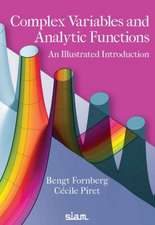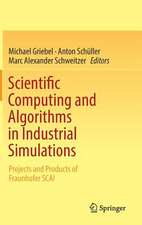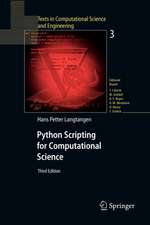Finite Difference Computing with PDEs: A Modern Software Approach: Texts in Computational Science and Engineering, cartea 16
Autor Hans Petter Langtangen, Svein Lingeen Limba Engleză Hardback – 7 iul 2017
This easy-to-read book introduces the basics of solving partial differential equations by means of finite difference methods. Unlike many of the traditional academic works on the topic, this book was written for practitioners. Accordingly, it especially addresses: the construction of finite difference schemes, formulation and implementation of algorithms, verification of implementations, analyses of physical behavior as implied by the numerical solutions, and how to apply the methods and software to solve problems in the fields of physics and biology.
| Toate formatele și edițiile | Preț | Express |
|---|---|---|
| Paperback (1) | 442.33 lei 6-8 săpt. | |
| Springer International Publishing – aug 2018 | 442.33 lei 6-8 săpt. | |
| Hardback (1) | 451.55 lei 6-8 săpt. | |
| Springer International Publishing – 7 iul 2017 | 451.55 lei 6-8 săpt. |
Din seria Texts in Computational Science and Engineering
-
 Preț: 400.26 lei
Preț: 400.26 lei - 19%
 Preț: 544.68 lei
Preț: 544.68 lei - 4%
 Preț: 466.32 lei
Preț: 466.32 lei - 20%
 Preț: 325.00 lei
Preț: 325.00 lei - 15%
 Preț: 595.86 lei
Preț: 595.86 lei - 20%
 Preț: 588.53 lei
Preț: 588.53 lei -
 Preț: 389.11 lei
Preț: 389.11 lei -
 Preț: 416.01 lei
Preț: 416.01 lei -
 Preț: 430.21 lei
Preț: 430.21 lei -
 Preț: 439.07 lei
Preț: 439.07 lei -
 Preț: 494.11 lei
Preț: 494.11 lei - 15%
 Preț: 608.08 lei
Preț: 608.08 lei -
 Preț: 394.87 lei
Preț: 394.87 lei -
 Preț: 393.90 lei
Preț: 393.90 lei -
 Preț: 387.75 lei
Preț: 387.75 lei -
 Preț: 504.50 lei
Preț: 504.50 lei -
 Preț: 396.62 lei
Preț: 396.62 lei -
 Preț: 482.45 lei
Preț: 482.45 lei - 20%
 Preț: 338.03 lei
Preț: 338.03 lei -
 Preț: 498.91 lei
Preț: 498.91 lei -
 Preț: 398.35 lei
Preț: 398.35 lei -
 Preț: 390.84 lei
Preț: 390.84 lei
Preț: 451.55 lei
Nou
Puncte Express: 677
Preț estimativ în valută:
86.41€ • 90.40$ • 71.78£
86.41€ • 90.40$ • 71.78£
Carte tipărită la comandă
Livrare economică 03-17 aprilie
Preluare comenzi: 021 569.72.76
Specificații
ISBN-13: 9783319554556
ISBN-10: 3319554557
Pagini: 507
Ilustrații: XXIII, 507 p. 150 illus.
Dimensiuni: 178 x 254 x 36 mm
Greutate: 1.13 kg
Ediția:1st ed. 2017
Editura: Springer International Publishing
Colecția Springer
Seria Texts in Computational Science and Engineering
Locul publicării:Cham, Switzerland
ISBN-10: 3319554557
Pagini: 507
Ilustrații: XXIII, 507 p. 150 illus.
Dimensiuni: 178 x 254 x 36 mm
Greutate: 1.13 kg
Ediția:1st ed. 2017
Editura: Springer International Publishing
Colecția Springer
Seria Texts in Computational Science and Engineering
Locul publicării:Cham, Switzerland
Cuprins
Preface.- Vibration ODEs.- Wave Equations.- Diffusion equations.- Advection-dominated equations.- Nonlinear problems.- Useful formulas.- Truncation error analysis.- Software engineering: wave equation model.- References.- Index.
Notă biografică
Svein Linge is a professor of modelling and simulation at the University College of Southeast Norway and holds a Dr. Scient. degree in biomechanics from the Norwegian School of Sport Sciences. He works part-time at a Norwegian Center of Excellence: "Center for Biomedical Computing", at Simula Research Laboratory, to which he has been linked for the last 13 years. His main research interests includes cerebrospinal fluid dynamics, cardiac electro-mechanics and sport biomechanics. Over the last decade, Linge has been particularly engaged in reforming the engineering education in mathematics and physics to take advantage of computer programming and simulation.
Hans Petter Langtangen was a professor of computer science at the University of Oslo. He had formerly been a professor of mechanics and was the director of a Norwegian Center of Excellence: "Center for Biomedical Computing", at Simula Research Laboratory. Langtangen published over 100 scientific publications and written several books, including papers and the bestseller TCSE 6 "A Primer on Scientific Programming with Python", now in its 5th edition. He also developed open source and commercial software systems for computational sciences. Hans Petter Langtangen passed away in October 2016.
Hans Petter Langtangen was a professor of computer science at the University of Oslo. He had formerly been a professor of mechanics and was the director of a Norwegian Center of Excellence: "Center for Biomedical Computing", at Simula Research Laboratory. Langtangen published over 100 scientific publications and written several books, including papers and the bestseller TCSE 6 "A Primer on Scientific Programming with Python", now in its 5th edition. He also developed open source and commercial software systems for computational sciences. Hans Petter Langtangen passed away in October 2016.
Textul de pe ultima copertă
This book is open access under a CC BY 4.0 license.
This easy-to-read book introduces the basics of solving partial differential equations by means of finite difference methods. Unlike many of the traditional academic works on the topic, this book was written for practitioners. Accordingly, it especially addresses: the construction of finite difference schemes, formulation and implementation of algorithms, verification of implementations, analyses of physical behavior as implied by the numerical solutions, and how to apply the methods and software to solve problems in the fields of physics and biology.
This easy-to-read book introduces the basics of solving partial differential equations by means of finite difference methods. Unlike many of the traditional academic works on the topic, this book was written for practitioners. Accordingly, it especially addresses: the construction of finite difference schemes, formulation and implementation of algorithms, verification of implementations, analyses of physical behavior as implied by the numerical solutions, and how to apply the methods and software to solve problems in the fields of physics and biology.
Caracteristici
An easy-to-read text explaining the ideas behind finite Uses fundamental PDEs to illustrate the path from algorithm to well-designed, complete computer code Explains and demonstrates the skill of verifying computer code on the basis of numerous examples Elaborates on artifacts in simulation results, further enhancing readers’ understanding Includes supplementary material: sn.pub/extras





























